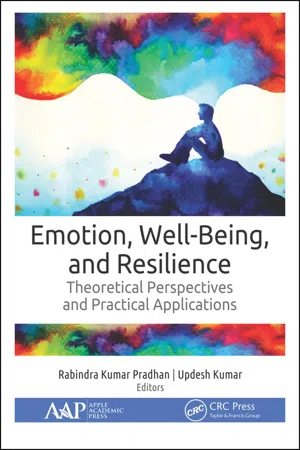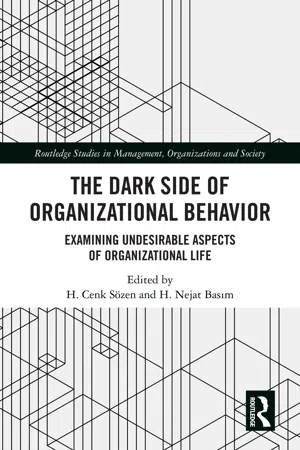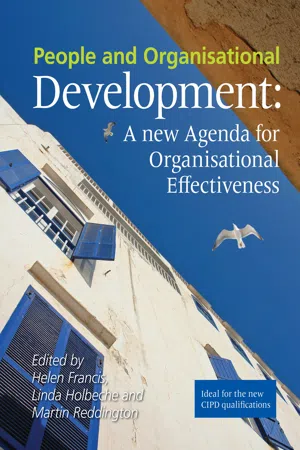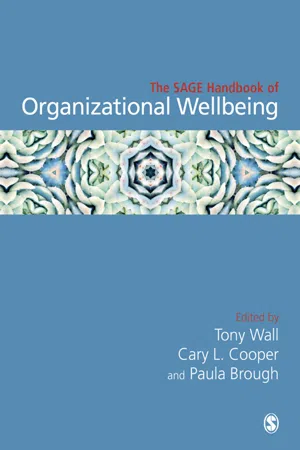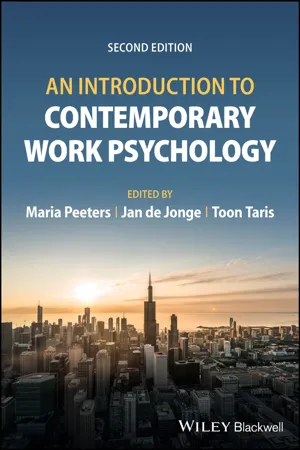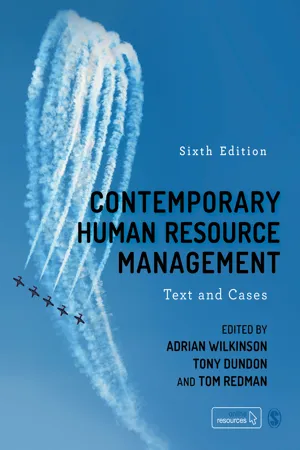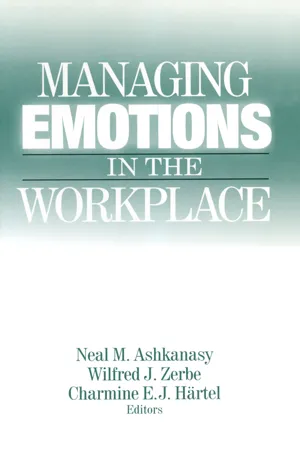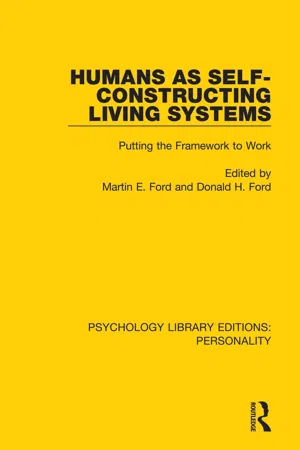Business
Work Emotions
Work emotions refer to the feelings and moods experienced by individuals in the workplace. These emotions can include a wide range of feelings such as satisfaction, frustration, motivation, stress, and happiness, among others. Managing work emotions is important for maintaining a positive work environment and ensuring productivity and well-being among employees.
Written by Perlego with AI-assistance
Related key terms
10 Key excerpts on "Work Emotions"
- eBook - ePub
Emotion, Well-Being, and Resilience
Theoretical Perspectives and Practical Applications
- Rabindra Kumar Pradhan, Updesh Kumar, Rabindra Kumar Pradhan, Updesh Kumar(Authors)
- 2021(Publication Date)
- Apple Academic Press(Publisher)
Various approaches to emotion work suggest that emotions are handled at work setting so as to meet organizational rules. Ashforth and Humphrey (1993) laid more emphasis on emotion work as an expressive behavior. They focused on the association between visible manifestation and task performance. According to them, if employees are not able to express their feelings genuinely, then emotion work becomes negative, thus affecting the organizational functioning. Grandey (2000) described emotion work as the process of regulating feelings and expression in order to fulfill the expectations of the organization. According to him, individual differences exist in emotion work with regard to gender, emotional intelligence, self-monitoring, and emotional expressivity. The work environment of an organization depends upon the level and type of emotion work displayed by the employees. Emotions play an active role in work-place learning (Wall et al., 2017). Learning is more effective when people are more positively engaged in work (Hazelton, 2014).19.2.2 EMOTION TYPES
Emotions are affective states occurring at both conscious and unconscious levels. Work incorporates a wide range of positive and negative emotions. At the organizational level, individuals express positive emotions when they are able to meet their goals. By cultivating positive emotions, people are able to improve their health and well-being. Negative emotions are unpleasant states displayed through the feelings of sadness, fear, anxiety, worry, and disappointment. They are experienced when people fail in their abilities to achieve the objectives and express inefficient emotional management. Positive emotions serve as a protective factor in guarding individual from negative emotions. Zautra et al. (2001) proposed the dynamic model of affect. The model suggests that under normal conditions, positive and negative emotions are fairly independent. During stressful situations, an inverse relationship increases between negative and positive emotions. Enhancing positive emotions during stress help in reducing the effect of negative emotions. Lack of positive emotions makes an individual more vulnerable to the effects of stress. Positive emotions can undo the effects of negative emotions by generating quicker returns to baseline levels of cardiovascular activation (Fredrickson et al., 2000). Well-being in the organization is characterized by an employee’s positive emotional states. According to Fredrickson and Losade (2005), the ratio of positive and negative emotions is highly beneficial for understanding the well-being of an individual. In order to maintain well-being, higher rate of positive emotions is required to subside the effects of negative emotion. - eBook - ePub
Managing and Leading People through Organizational Change
The Theory and Practice of Sustaining Change through People
- Julie Hodges(Author)
- 2021(Publication Date)
- Kogan Page(Publisher)
There is comparatively little discussion in the organizational change literature on the emotional side of change – that is, how individuals react to issues that impact on them personally in the work environment. Not only is there a lack of attention paid to emotions in the literature but there also appears to be an unwritten rule in most organizations that employees should leave their emotions at the door. In many companies only emotions that are easily controllable and can be categorized as positive are permitted, however organizations that advocate this approach fail to see the importance of emotions at work. As Noel Tichy and Stanford Sherman rightly observe: ‘work, inevitably is an emotional experience; healthy people can’t just drop their feelings off at home like a set of golf clubs’ (1993: 64). Emotions at work matter, because as Jon Elster says:Most simply, emotions matter because if we did not have them nothing else would matter. Creatures without emotion would have no reason for living... Emotions are the stuff of life. Emotions are the most important bond or glue that links us together. (1999: 403)The experience of work is saturated with a variety of emotions ranging from frustration, anxiety or fear, to an enduring sense of satisfaction and even happiness. Emotions influence attitudes, behaviour, and what individuals do and how they do it at work. Research shows that positive emotional experiences at work can lead to an improvement in a person’s performance, while negative emotional experiences can have the opposite effect (Fredrickson and Losada, 2005). So emotions do matter at work.When change occurs in an organization it can create a multitude of emotions, from despondency and despair to feelings of emancipation and joy, depending on the nature of the change and its potential impact. Change can be a threat or an opportunity, a cause for concern or celebration, surprising or predictable, controlled or uncontrolled. It can bring growth and prosperity, create progress and maturity, but it can also bring chaos and decay, and result in the sudden end of all development and progression. It is not surprising, then, that change inspires an immense gamut of emotional responses, ranging from nostalgia for the status quo to hope and anticipation for what the future will be like. - eBook - ePub
The Dark Side of Organizational Behavior
Examining Undesirable Aspects of Organizational Life
- H. Cenk Sözen, H. Nejat Basım, H. Cenk Sözen, H. Nejat Basım(Authors)
- 2022(Publication Date)
- Routledge(Publisher)
Hochschild’s (1983) studies on emotional labor was a turning point for research on emotions. Following Hochschild’s work, emotions captured the attention of mainstream organizational behavior researchers (Rafaeli and Sutton, 1989; Ashkanasy and Dorris, 2017) and such topics as job satisfaction and performance (Iverson, Olekalns and Erwin, 1998), job attitudes (Weiss and Cropanzano, 1996), motivation (George and Brief, 1996), leadership (Walter and Bruch, 2009; Ge, Tian and Fu, 2012) and person-organization fit (Kristof, 1996; Sekiguchi, 2004; Kristof-Brown, Zimmerman and Johnson, 2005) were revisited in the light of emotions and new such topics as emotional intelligence (Ashkanasy and Daus, 2002), emotional labor (Grandey, 2000; Hochschild, 1983) and emotion regulation (Van Dijk and Brown, 2006) emerged in the organizational behavior literature. Some of the recent studies focus on emotions as a unilateral phenomenon with a oneway effect such as the effect of emotions on decision-making or behavior (Schwarz, 1990; Schwarz and Clore, 1983) while others inquire a two-way reciprocal relation such as how organizational environments trigger specific emotions and, in turn, how emotions lead to certain organizational attitudes and behaviors (Ashton-James and Ashkanasy, 2008; Schwarz, 2002).Generating higher degrees of response flexibility, emotions function as a survival mechanism for individuals to adapt to complex positive and negative environmental conditions (Smith and Lazarus, 1990). Emotions emerge as a reaction to a certain experience (Tanyolaç and Şenyuva, 2019) and consecutively influence behavior in response to such experience (Smith and Lazarus, 1990). Positive emotions, such as satisfaction, caring, passion, eagerness, optimism, hope and enthusiasm, and negative emotions, such as envy, jealousy, anxiety, anger, disappointment, insecurity and loneliness, are the outcomes of positive and negative experience in organizational environments; and this chapter specifically focuses on negative emotions at work settings.Emotions
Frijda (1986) defines emotion as the “experience of a form of biological response to environmental stimulus, resulting in physical and psychological changes and subsequent readiness for action” (Ashkanasy and Dorris, 2017: 286). Emotions at work may be produced through exogenous factors such as “diurnal and recurring cycles in feelings over time and dispositional influences on affective states” (Ashkanasy and Dorris, 2017: 286) as well as stressful events and conditions at work, leader–member relations and leadership styles, work group characteristics, physical settings, organizational reward and punishment systems (Brief and Weiss, 2002).Emotions signal clues from the outside world regarding what needs response(s) or what does not need further reaction and attention (Frijda, 1988). Emotions may be directed toward a person, an object or a situation and provide us with information about the environment around us, thus serving an informative function (Schwarz, 2002). When the information received about a person or an event is perceived as problematic, individuals process such information in a more detailed manner with more consideration compared to such other information perceived as favorable in which they use the already-available or taken-for-granted patterns of thoughts from their past experience, paying less attention and effort to the particulars of the specific event (Wegner and Vallacher, 1986; Schwarz, 2002). - eBook - ePub
People and Organisational Development
A New Agenda for Organisational Effectiveness
- Helen Francis, Linda Holbeche, Martin Reddington(Authors)
- 2012(Publication Date)
- CIPD - Kogan Page(Publisher)
Organisations are places of emotion and objects of emotion. To navigate organisations is to navigate the complexities of the emotional webs within them. Emotions are not incidental to, or disruptive of, work or organisational life – they are an essential part of the human experience of work.This chapter provides an initial insight into the complex nature of individual affective experience at work, placing employees and their emotions and moods at the centre of a dynamic, changing interplay between individual and context. It emphasises both the individual elements of emotional experience, such as the duration or intensity of personal feeling (eg the difference between emotion and mood), and contextual elements, such as the impact of culture on how the emotion is experienced, talked about and shown to others (eg the difference between feeling and emotion display) – see Table 16.1 (eg Weiss, 2002; Fineman, 2003).Table 16.1 Elements of affective experienceThe chapter aims to connect academic and practitioner thinking on emotion at work, by blending short case studies with theoretical models, evidence and expert commentaries. Throughout the links to both classical and new, emerging models of OD will be stressed (see Chapter 1), and there are opportunities for reflection to improve OE practice.CLASSICAL MODELS OF EMOTION AT WORK
Researchers, managers and allied professionals have been interested in individual affective experience (emotion and mood) for nearly 100 years. This section reviews how this body of understanding has shaped the way emotion at work has come to be currently understood.the happy-productive worker and emotion as ‘win/win’
The emergence of the interest in affect at work is typically traced to studies conducted in the 1930s and the birth of the Human Relations movement. Several influential studies from this period investigated emotion at work in all its complexity, exploring how emotions and moods varied from moment to moment and from day to day – how they were shaped by work itself, by broader social work groups, by the individual’s home environment and also by their personality and attitudes (see Weiss and Brief, 2001, for a historical review). This early work was hugely influential; it established the individual and his or her feelings about work as important and legitimate topics for both scientific study and management or HR action. - eBook - ePub
- Tony Wall, Cary L Cooper, Paula Brough, Tony Wall, Cary L Cooper, Paula Brough(Authors)
- 2021(Publication Date)
- SAGE Publications Ltd(Publisher)
5 Emotions and Wellbeing at Work: A Multilevel Perspective Ashlea C. Troth, Alannah E. Rafferty, and Peter J. JordanIntroduction
It's business, leave your emotions at the door. The Wolf of Wall StreetInterest in how emotions shape organizational attitudes and behaviors has risen over the last couple of decades among scientists and practitioners (Ashforth and Humphrey, 1995; Barsade and Gibson, 2007; Hochschild, 1983). Appreciation of the critical role of workplace emotions emerged during the 1980s. Prior to this, the idea of emotions at work was viewed as ancillary to the more ‘rational’ concepts of scientific management, which focused on industrial productivity and effectiveness (Ashkanasy et al., 2017). This led to the idea – as evidenced by the opening quote – that emotions were to be ignored as an annoyance at best or, at worst, as something to be eliminated. Unsurprisingly, employee wellbeing was not given much attention at this time either. If it was considered, then the role of emotions – both their experience and expression – was generally seen as something reflective of poor mental health and low control (i.e., reflective of neuroticism and anxiety; Putnam and Mumby, 1993). In this chapter, we argue that emotions should be seen as an essential component in all workplaces and that the appropriate management of emotions can lead to better employee wellbeing.Fortunately, it is now widely recognized that emotions are inevitable in the workplace and play a complex role, including a positive one, in relation to wellbeing (Bakker and Oerlemans, 2011). The phrase ‘the Affective Revolution’ (Barsade et al., 2003) has been coined to describe the transformation of the workplace from an‘effective no-go zone’ for emotions to one where understanding the role of emotions is now seen to be de rigueur - eBook - ePub
- Maria C.W. Peeters, Jan de Jonge, Toon Taris(Authors)
- 2023(Publication Date)
- Wiley-Blackwell(Publisher)
Section 7.3 .When completing their work, employees compare the current situation (e.g., task progress, feelings, and emotional expressions) with task and emotion job requirements (see Figure 7.1 , middle) and evaluate whether they need to adjust their task behavior and their emotional expression. Regarding emotional expression, employees may use various emotion regulation strategies (such as surface acting or deep acting; see below) to adjust their feelings and their emotional expressions in order to meet emotion job requirements. This process is at the heart of emotion work and discussed in Section 7.4 .Emotion work has an impact on employee well-being and also influences organizational functioning; this is shown on the right side of Figure 7.1 . Finally, we assume that different moderators influence these relations. Examples are personality variables such as positive or negative affect (see also Chapter 11 ) or characteristics of the work situation such as control or social support (see Chapter 4 ). In the next section, we will look at the emotion work requirements.Work Psychology in Action: An example of emotion work
A young businessman said to a flight attendant: “Why aren’t you smiling?” She put her tray back on the food cart, looked him in the eye, and said: “I’ll tell you what. You smile first, then I’ll smile.” The businessman smiled at her. “Good,” she replied. “Now freeze, and hold that for fifteen hours.” Then she walked away (Hochschild, 1983 , p. 127).7.3 Emotion Work Requirements
Part of the model concerns emotion work requirements, that is, the requirements to express and sense emotions in interactions with others, in line with situational characteristics. These include emotions displayed by the interaction partner, and perceiving these correctly implies sensitivity requirements (see the box “emotion work requirements” in Figure 7.1 ). How frequently employees need to sense and express certain emotions specifies the requirements for emotion regulation. They largely determine the extent to which employees must regulate their feelings and/or expressions in order to meet the requirements defined by the display rules (Zapf et al., 2021 ). Emotion work requirements vary considerably from job to job and often also within jobs (Humphrey et al., 2008 ; Kern et al., 2021 - eBook - ePub
Contemporary Human Resource Management
Text and Cases
- Adrian Wilkinson, Tony Dundon, Adrian Wilkinson, Tony Dundon(Authors)
- 2021(Publication Date)
- SAGE Publications Ltd(Publisher)
This chapter will discuss this emotional turn in the context of HRM, with implications for organisational performance and employee well-being. We discuss the social view of emotions in employment, as well as research from an organisational psychology perspective, which has focused on individuals’ emotional regulation and intelligence, with alleged links to organisational performance (Gross, 1998; Mayer and Salovey, 1997). We will show how theories and research in the HR tradition have evolved to take a critical and social perspective on emotions that recognises the broader range of organisational, occupational, sectoral and national contexts that all shape how emotions are managed, performed and experienced at work. The chapter will also identify a new research agenda around the customer as a key actor in HRM and employment relationships. The formal measures introduced by organisations to help alleviate some of the demands of performing emotion at work alongside the informal coping mechanisms of employees will also be discussed. Case studies at the end of the chapter will then give readers the opportunity to apply these ideas to contemporary employment contexts.Emotion in Management Theory and Practice
While ‘emotions’ are often thought of as personal and individual, an analysis of emotions in HR research reveals a critical social view of emotions. This moves beyond ‘psychologising’ emotions as inward ‘within-person phenomena’ (Fineman, 2000) to an approach which recognises emotions as a dynamic and social process. In this approach, while emotions shape human perceptions and understandings, emotions are themselves products of the way social systems of meaning are created and negotiated between people to tell us how to feel (Fineman, 2000). This recognises how we perform rather than just feel the most personal of emotions; as Fineman (2004) notes, ‘“doing” anger, love, excitement, so forth – can be seen to be embedded in social cultural protocols that often have a strategic role in interpersonal relations’ (2004: 722). - eBook - ePub
- Neal M. Ashkanasy, Wilfred J. Zerbe, Charmine E. J. Hartel(Authors)
- 2016(Publication Date)
- Routledge(Publisher)
1 Managing Emotions in a Changing Workplace Neal M. Ashkanasy, Wilfred J. Zerbe and Charmine E.J. HärtelDOI: 10.4324/9781315290812-1Introduction
The modern workplace is often thought of as cold and rational, as no place for the experience and expression of emotions. Yet it is no more emotionless than any other aspect of social life (Ashforth and Humphrey 1995; Ashkanasy, Härtel, and Zerbe 2000b; Fisher and Ashkanasy 2000). Individuals bring their affective states and traits and emotional “buttons” to work; leaders try to engender in followers feelings of passion and enthusiasm for the organization and its well-being; groups speak of esprit de corps; and organizational consultants seek to increase job satisfaction, commitment, trust, and loyalty. Organizational members seldom carry out their work in an objective fashion based on cold, cognitive calculation. Instead, as Weiss and Cropanzano (1996) argue, workplace experiences comprise a succession of work events that can be pleasing and invigorating, or stressful and frustrating. Without a doubt, emotions are an inherent part of the workplace.In recent years, we have witnessed a rise in the organized study of emotions in the workplace. The editors of this book have been at the forefront of this rise, including the publication of Emotions in the Workplace: Theory, Research, and Practice (Ashkanasy, Härtel, and Zerbe 2000a), the forerunner to the present volume. Ashkanasy was also guest editor (with Cynthia Fisher) of a Special Issue of the Journal of Organizational Behavior on this topic. Other books that are contributing to this rise are by Fineman (2000); Ciarrochi, Forgas, and Mayer (2001); Lord, Klimoski, and Kanfer (2001); and Payne and Cooper (2001); and special editions of Organizational Behaviour and Human Decision Processes (Weiss 2001) and Leadership Quarterly (Humphrey, planned for 2002). An additional book is in preparation by Weiss, Cropanzano, and Ashkanasy (in press). Finally, the renewed interest is evident in the strong support of the biannual Conferences on Emotions and Organizational Life - eBook - ePub
Humans as Self-Constructing Living Systems
Putting the Framework to Work
- Martin E. Ford, Donald H. Ford(Authors)
- 2019(Publication Date)
- Routledge(Publisher)
Thus, the term emotion refers to a smaller range of bodily states than does the term affect. Emotions are also specific to particular behavior episodes and are, therefore, time limited. They will dissipate when the behavior episode changes or ends. However, certain thoughts, as well as current events, can continue to trigger emotions and produce an emotional state that is maintained over a longer time frame. This can be thought of as a mood. The focus of the present study, however, is on emotions rather than other affective states or moods. Rationale for this Study Traditionally, the field of Organizational Behavior has focused on people’s actions in organizations and on the effects of various work contexts on their actions (Staw, 1984). However, in the past two decades researchers have become increasingly concerned with the psychological processes associated with actions in organizations. This concern has led to research on the role of cognitions in organizational behavior, and has resulted in new ways of interpreting some of the traditional outcomes that the field has explored in the past (Staw, 1984). Yet, the potential importance of emotions in people’s behavior in organizations has largely been overlooked. This is evidenced by the fact that a review of the Business Citation Index from August, 1977 to December, 1984 revealed only a single citation under the heading of “Emotions” in an academic management journal. Despite the fact that emotions play a significant role in basic Organizational Behavior variables such as motivation (Izard, 1978; Klinger, 1977; Tomkins, 1978), learning (Masters, Barden, & Ford, 1979), attribution (Weiner, 1980, 1982), memory and recall of information (Bower & Cohen, 1982), social cognitions (Fiske, 1982; Hammen & Peters, 1978; Wright & Mischel, 1982), and stress (McGrath, 1983), there is almost no information on the role that emotions play in the daily life of an executive - eBook - ePub
- Charmine Hartel, Neal M. Ashkanasy, Wilfred Zerbe(Authors)
- 2005(Publication Date)
- Psychology Press(Publisher)
For example, some occupations “often require frequent changes of emotions that are displayed: positive emotions to build enthusiasm, negative emotions to support discipline and neutrality of emotions to demonstrate fairness and professionalism” (Morris & Feldman, 1996, p. 992). In the theatrical arts, actors often talk about “range” in reference to the ability to play a wide variety of characters and across multiple genres (e.g., slapstick comedy vs. Shakespearean theater). Similarly, service employees are often called on to express a wide range of emotions in order to successfully perform on the job. Some of these emotional expressions may even contradict one another. For example, an employee might force a smile while communicating a tough policy issue to a customer in a firm voice. Few researchers have explored this idea empirically, but there are similar theoretical conceptions (Grandey, 2000 ; Wharton & Erickson, 1993). Our proposition is that jobs requiring a wide range of emotions and/or multiple emotions to express simultaneously have a greater impact on one's emotional state than jobs requiring only a few emotions to be expressed. Much like cognitive load, perceived dissonance could increase under such circumstances. The situational demands just outlined seem to contribute to an individual's overall affective state. Clearly, a single property may not produce a significant change in the emotional state; however, the cumulative effect contributes to the experienced state
Index pages curate the most relevant extracts from our library of academic textbooks. They’ve been created using an in-house natural language model (NLM), each adding context and meaning to key research topics.
